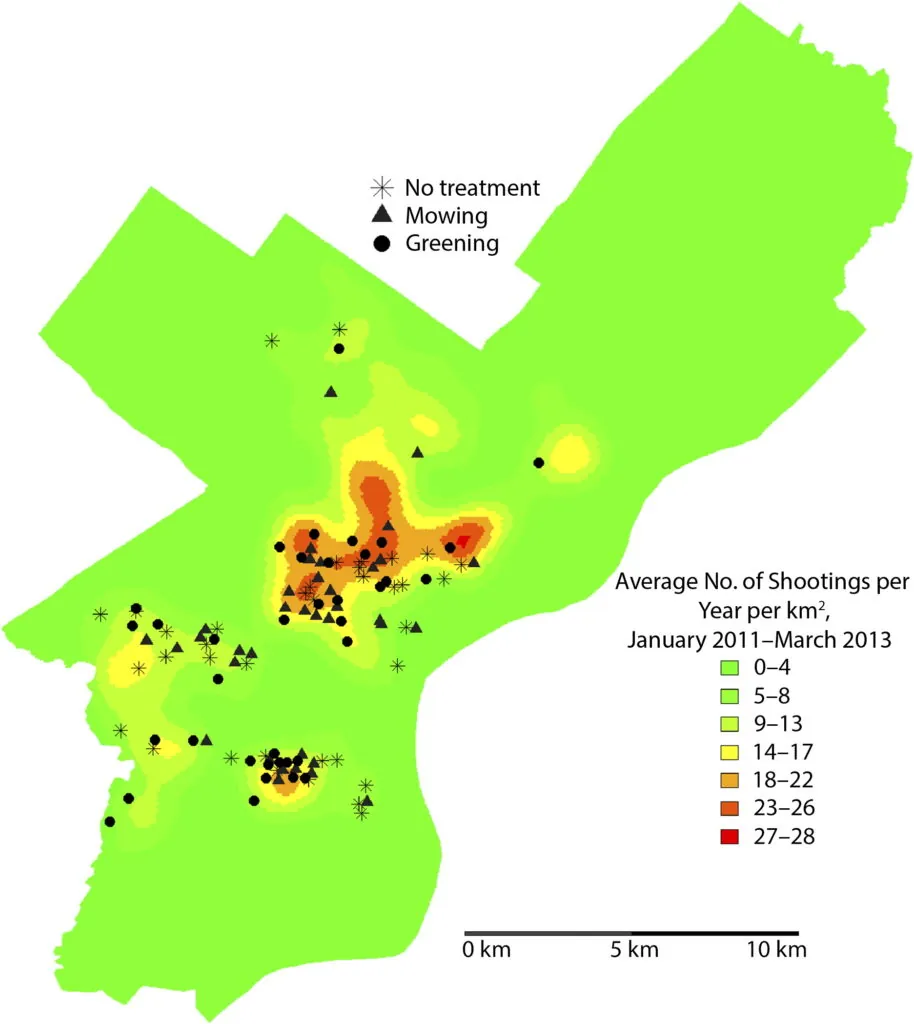The Greening of Vacant Lots
In a reversal of the broken window theory, greened lots restored a sense of pride and belonging to neighborhoods, discouraging crime and gun violence.

Read Time: 3 minutes
Published:
Deindustrialization and suburban expansion have left many American cities with thousands of vacant properties. In fact, one analysis identified 60 cities with at least two vacant properties for every 1,000 residents. More than just an eyesore, vacant or abandoned properties can affect residents’ physical and mental health conditions, and have been associated with neighborhood gun violence.
The “broken window” theory provides a framework for understanding how vacant properties affect the larger community. Vacant properties weaken social ties and the deterioration of both physical buildings and relationships comes to symbolize a lack of accountability. This theory helps explain why the same neighborhoods struggling with urban decay and vacant properties often face a higher risk of gun violence.
The remediation of these properties is a landscaping process called greening, which involves clearing debris, planting grass and trees, and adding fences. Over the past 15 years, the Pennsylvania Horticultural Society has greened more than 16 million square feet of formerly-vacant land in Philadelphia. Their efforts have been linked to lower stress levels, more exercise, and a decrease in total gun assaults.
Photo via Ruth Moyer, John M. MacDonald, Greg Ridgeway, and Charles C. Branas, Effect of Remediating Blighted Vacant Land on Shootings: A Citywide Cluster Randomized Trial. American Journal of Public Health (AJPH).
To better evaluate the potential effect of greening on gun violence in Philadelphia, where about one-third of all of gun violence occurred within just 6% of city blocks, researchers narrowed their focus in a new study from gun assaults to only gun incidents resulting in serious injury or death. The shapes on this map indicate the locations of vacant lot groups and which ground treatment (greening, mowing and trash removal, or no treatment) was administered. The colors represent the average annual number of shootings in neighborhoods across the city before the study began.
Between April and June of 2013, 547 vacant lots randomly received one of the three possible ground treatments. Properties receiving greening or trash removal also received maintenance and upkeep until March 2015.
In a reversal of the broken window theory, greened lots restored a sense of pride and belonging to neighborhoods, discouraging crime.
The greened and cleaned areas significantly reduced the average number of shootings per kilometer by 6.8% and 9.2%, respectively. More detailed area-based analyses found that both interventions decreased the average number of monthly shootings in the 300 and 600-meters surrounding the treated lots. Taken together, these analyses suggest both remediation options actually decreased shootings within or adjacent to vacant lots, as opposed to simply displacing such violence into adjacent neighborhoods or properties.
Although the exact mechanism connecting greening and reductions in gun violence is unknown, the researchers theorize greened properties promotes community. In a reversal of the broken window theory, greened lots restored a sense of pride and belonging to neighborhoods, discouraging crime.
Official estimates place the number of vacant lots in Philadelphia at around 40,000, so remediating them all would require a vast expansion of efforts like those of the Pennsylvania Horticultural Society.
Photo by Fredy Martinez on Unsplash




